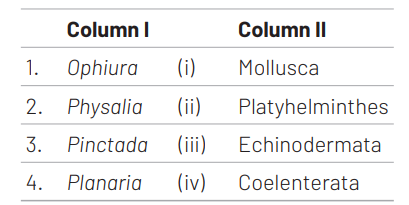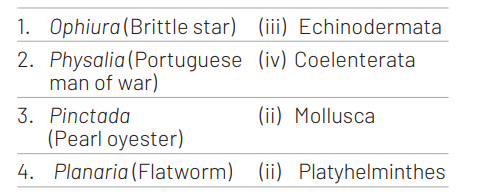Question
Read the following statements. [NEET 2021]
I. Metagenesis is observed in helminths.
II. Echinoderms are triploblastic and coelomate animals.
III. Round worms have organ-system level of body organisation.
IV. Comb plates present in ctenophores help in digestion.
V. Water vascular system is characteristic of echinoderms.
Choose the correct answer from the options given below.
(a) III, IV and V are correct
(b) I, II and III are correct
(c) II. IV and V are correct
(d) II, III and V are correct
Answer/Explanation
Ans. (d)
Statements II, III and V are correct, while statements I and IV are incorrect. Incorrect statement can be corrected as-
Comb plates are present in ctenophores which help in locomotion or swimming and not in digestion.
Metagenesis is the alternation of generations between sexual and asexual reproduction. In helminths metagenesis is not observed.
Question
Match the following genera with their respective phylum [NEET (Odisha) 2019]
Select the correct option from the following
$\begin{array}{llll}1 & 2 & 3 & 4\end{array}$
(a) (iv) (i) (iii) (ii)
(b) (iii) (iv) (i) (ii)
(c) (i) (iii) (iv) (ii)
(d) (iii) (iv) (ii) (i)
Answer/Explanation
Ans. (b)
The correct matches are

Question
The animal with bilateral symmetry in young stage and radial pentamerous symmetry in the adult stage belong to the phylum [CBSE AIPMT 2004]
(a) Annelida
(b) Mollusca
(c) Cnidaria
(d) Echinodermata
Answer/Explanation
Ans. (d)
Echinoderms are triploblastic animals with organ system level of organisation. Larval forms possess bilateral symmetry while adults have radial symmetry.
Question
Radial symmetry is usually associated with [CBSE AIPMT 1996] (a) aquatic mode of life
(b) lower grade of organisation
(c) creeping mode of locomotion
(d) sedentary mode of life
Answer/Explanation
Ans. (b)
In radial symmetry body is in the form of flat or tall cylinder and can be divided into similar halves by more than two planes passing through one main axis. It is found in some sponges, hydras, jellyfish, sea urchin, etc.
Question
The organisms attached to the substratum generally, possess [CBSE AIPMT 1995]
(a) radial symmetry
(b) one single opening of digestive canal
(c) asymmetrical body
(d) cilia on surface to create water current
Answer/Explanation
Ans. (a)
The organisms attached to the substratum, generally possess radial symmetry.
Question
Radial symmetry is often exhibited by animals having [CBSE AIPMT 1994]
(a) one opening of alimentary canal
(b) aquatic mode of living
(c) benthos/sedentary
(d) ciliary mode of feeding
Answer/Explanation
Ans. (b)
Radial animals are usually sessile, freely floating or weakly swimming.
Question
Tube feet occur in [CBSE AIPMT 1994]
(a) cockroach
(b) starfish
(c) cuttle fish
(d) cat fish
Answer/Explanation
Ans. (b)
In starfish locomotion takes place by external tube feet, connected with water vascular system.
Question
Aristotle’s lantern occurs in class [CBSE AIPMT 1992]
(a) Echinoidea
(b) Asteroidea
(c) Holothuroidea
(d) Ophiuroidea
Answer/Explanation
Ans. (a)
A biting or masticatory apparatus or Aristotle’s lantern’ is present in the members of class- Echinoidea.
Question
Star fish belongs to [CBSE AIPMT 1992]
(a) Asteriodea
(b) Ophiuroidea
(c) Holothuroidea
(d) Crinoidea
Answer/Explanation
Ans. (a)
Starfish belongs to class-Asteroidea.
Question
Which one occurs in Echinodermata? [CBSE AIPMT 1991]
(a) Bilateral symmetry
(b) Radial symmetry
(c) Porous body
(d) Soft skin
Answer/Explanation
Ans. (b)
Echinoderms are triploblastic and radially symmetrical but their larvae are bilaterally symmetrical.
